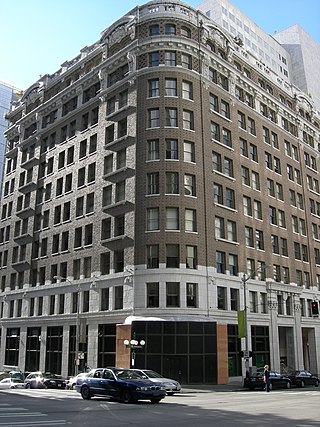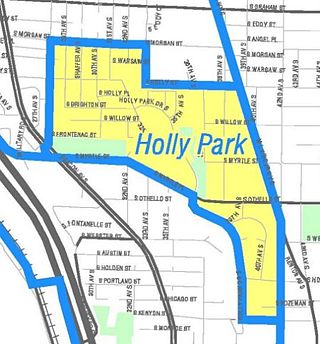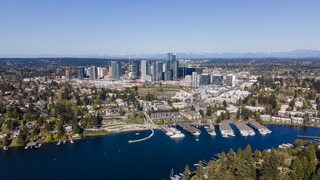
The Seattle Center is an entertainment, education, tourism and performing arts center located in the Lower Queen Anne neighborhood of Seattle, Washington, United States. Constructed for the 1962 World's Fair, the Seattle Center's landmark feature is the 605 ft (184 m) Space Needle, an official city landmark and globally recognized symbol of Seattle's skyline. Other notable attractions include the Pacific Science Center, Climate Pledge Arena, and the Museum of Pop Culture (MoPOP), as well as McCaw Hall, which hosts both the Seattle Opera and Pacific Northwest Ballet. The Seattle Center Monorail provides regular public transit service between the Seattle Center and Westlake Center in Downtown Seattle, and is itself considered a tourist attraction.

Seattle Children's is a children's hospital in the Laurelhurst neighborhood of Seattle, Washington, United States. The hospital specializes in the care of infants, children, teens, and young adults aged 0–21 in several specialties.

Delridge is a district in Seattle, Washington, United States that stretches along Delridge Way, an arterial that follows the eastern slope of the valley of Longfellow Creek, from near its source just within the southern city limits north to the West Seattle Bridge over the Duwamish River. It is generally associated with the neighborhing district of West Seattle, or even considered a sub-district of West Seattle.

The Metropolitan Tract is an area of land in downtown Seattle owned by the University of Washington. Originally covering 10 acres (40,000 m2), the 1962 purchase of land for a garage for the Olympic Hotel expanded the plot to 11 acres (45,000 m2). The Metropolitan Tract is primarily located in a rectangle formed by Seneca St., Third Ave., Union St., and Sixth Ave.

Westlake Center is a four-story shopping center and 25-story office tower in downtown Seattle, Washington, United States. The southern terminus of the Seattle Center Monorail, it is located across Pine Street from Westlake Park, between 4th and 5th Avenues. It is named for Westlake Avenue, which now terminates north of the mall but once ran two blocks farther south to Pike Street. Westlake Park is considered Seattle's "town square" and celebrities and political figures often make appearances or give speeches from the building's balcony. The anchor stores are Saks Off 5th and Nordstrom Rack.

Starfire Sports is a multi-purpose stadium and sporting facility in Tukwila, Washington, United States. It is located on the banks of the Green River, just south of Seattle. The stadium is operated by the nonprofit corporation Starfire Sports and is home to several soccer and rugby teams. At the time of its opening, CEO Chris Slatt claimed it was "the largest synthetic-turf soccer complex in the U.S."
Seattle Rep is a major regional theater located in Seattle, Washington, at the Seattle Center. Founded in 1963, it is led by Artistic Director Dámaso Rodríguez and Managing Director Jeffrey Herrmann.

Smith Cove is a body of water, the northern part of Seattle, Washington's Elliott Bay, immediately south of the area that has been known since 1894 as Interbay. More precisely, it is the part of the bay that lies north of a line running southeasterly from the west end of Elliott Bay Marina in the northwest to the far northwest tip of Myrtle Edwards Park in the southeast.

The Butler Hotel or Hotel Butler in Seattle, Washington, was one of Seattle's leading hotels in the late 19th and early 20th centuries. It was located at the corner of Second Avenue and James Street, in what is now the Pioneer Square-Skid Road National Historic District. During the Prohibition era, its Rose Room was repeatedly cited for flouting the laws against the consumption of alcoholic beverages. It closed in 1933; the lower two floors survive as part of the Butler Garage. The building itself is also known as the Butler Block, the name over the main entrance.

NewHolly is a neighborhood in southeastern Seattle, Washington, United States. It is part of Seattle's South End.

The Lester Apartments was a building on the west side of Beacon Hill, Seattle, Washington, United States. It was constructed in 1910–1911, originally intended to be the world's largest brothel. After scandal forced Seattle mayor Hiram Gill from office, the building was converted to be an ordinary apartment house. It met a disastrous end when a B-50 Superfortress crashed into it in 1951, causing a fire that engulfed the building.

Pike Place Market is a public market in Seattle, Washington, United States. It opened on August 17, 1907, and is one of the oldest continuously operated public farmers' markets in the United States. Overlooking the Elliott Bay waterfront on Puget Sound, it serves as a place of business for many small farmers, craftspeople and merchants. It is named for its central street, Pike Place, which runs northwest from Pike Street to Virginia Street on the western edge of Downtown Seattle. Pike Place Market is Seattle's most popular tourist destination and the 33rd most visited tourist attraction in the world, with more than 10 million annual visitors.

Callison was an international architecture firm based in Seattle, Washington. Callison was founded by Tony Callison in 1975 and grew to 900 employees around the world prior to its acquisition by Arcadis NV in 2014. In October 2015, Callison was formally merged with another Arcadis subsidiary, RTKL Associates, to form CallisonRTKL headquartered in Baltimore, Maryland.

The Central Waterfront is a neighborhood of Seattle, Washington. It is the most urbanized portion of the Elliott Bay shore. It runs from the Pioneer Square shore roughly northwest past Downtown Seattle and Belltown, ending at the Broad Street site of the Olympic Sculpture Park.

Downtown Bellevue is the central business district of Bellevue, Washington, United States. It is bounded by I-405 to the east, NE 12th Street to the north, 100th Ave NE to the west, and Main Street to the south, and covers an area of around 400 acres (160 ha). It is the second largest city center in Washington state, with more than 50,000 employees and 12,000 residents. Geographically centered near the heart of the Puget Sound region, downtown Bellevue is a regional growth center offering over 9 million square feet (840,000 m2) of Class A office space, various major retail and entertainment locations, more than 2,500 hotel rooms and almost 10,000 housing units.

ACT Contemporary Theatre is a regional, non-profit theatre organization in Seattle, in the US state of Washington. Gregory A. Falls (1922–1997) founded ACT in 1965 and served as its first Artistic director; at the time ACT was founded he was also head of the Drama Department at the University of Washington. Falls was identified with the theatrical avant garde of the time, and founded ACT because he saw the Seattle Repertory Theatre as too specifically devoted to classics.

The Grand Trunk Pacific dock was a shipping pier in Seattle, Washington. The original pier was built in 1910 and was destroyed in a fire in 1914. The pier was then rebuilt and continued in existence until 1964, when it was dismantled. The area where the pier stood is now part of the Seattle terminal of the Washington State Ferry system.

Pier 54 is a tourist pier in Seattle, Washington. Previously an active shipping pier and warehouse, Pier 54 was originally known as Pier 3 until it was renumbered during World War II. This pier was also known as Galbraith dock and the Galbraith Bacon dock. Because of the large number of smaller local steamships, generally built of wood, that used the pier up until the 1930s, the pier was also known as the “Mosquito Fleet dock”.

Pier 55 is a pier in Seattle, Washington. Pier 55 was originally known as Pier 4 until it was renumbered during World War Two.

Pier 57 is located in Seattle, Washington near the foot of University Street. Currently under private ownership, the pier is now a tourist attraction with gift shops and restaurants, and houses the Seattle Great Wheel.




















